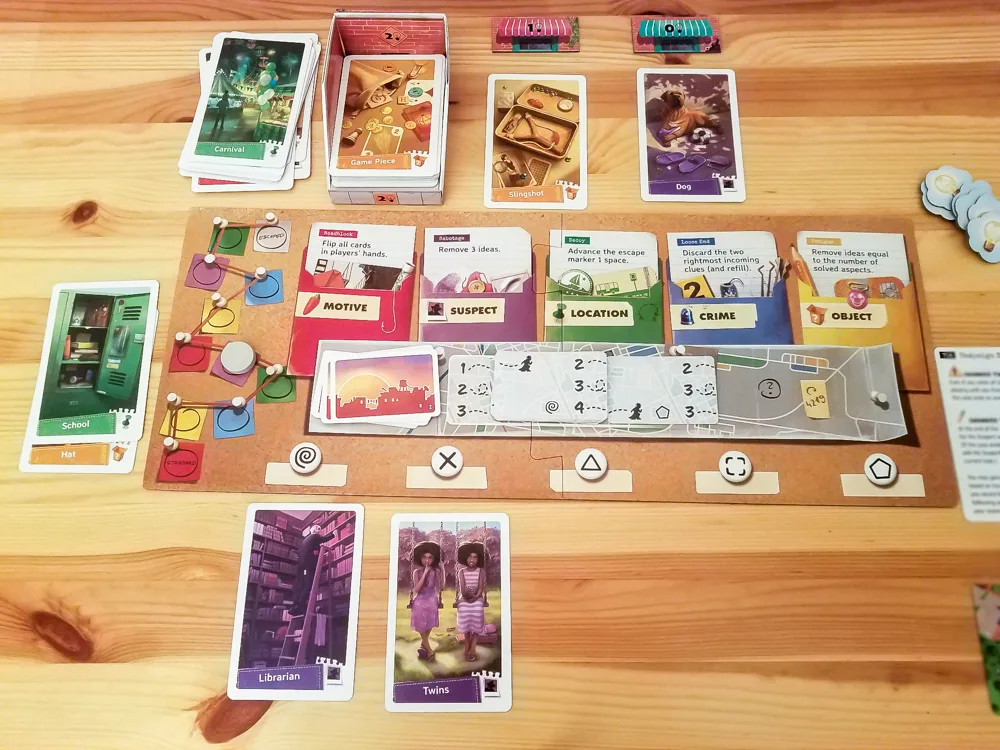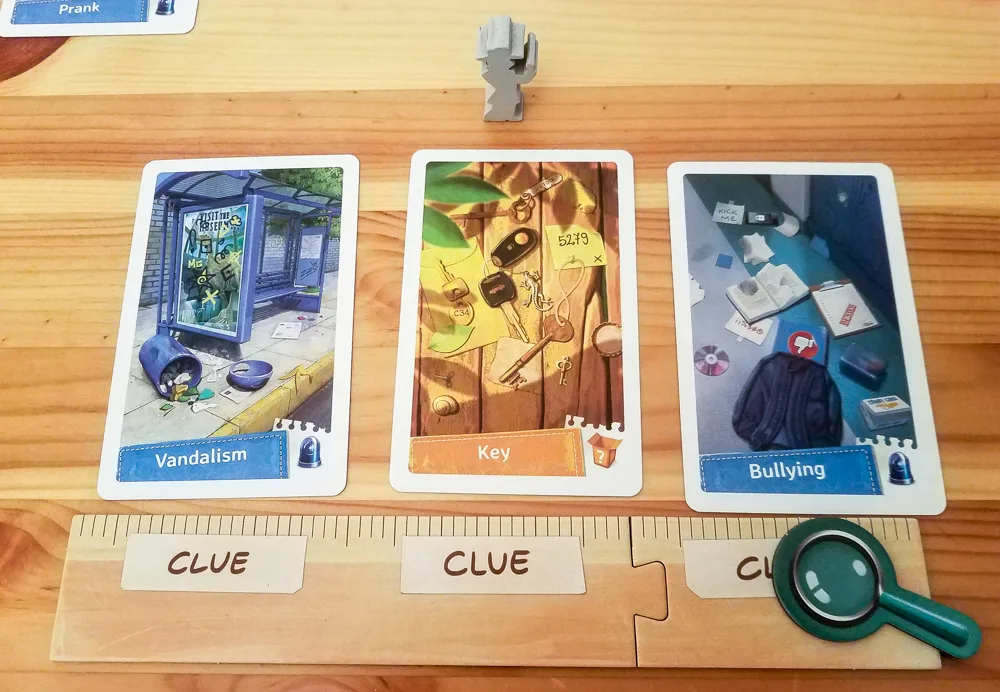Spy Club Review
Year: 2018 | Players: 2-4 | Minutes: 45 | Ages: 10+
This Spy Club review was made after playing the game 12 times (two standalone games and two campaigns). We were sent a copy of this game by the publisher in exchange for an honest review.
What is Spy Club?
In Spy Club, you and your teammates are young detectives attempting to piece together clues to solve cases. It is a campaign game in which you’re trying to solve five different cases to figure out the answers to a master case, but you can also play a single case.
Spy Club was designed by Randy Hoyt and Jason D. Kingsley, and it is co-published by Foxtrot Games and Renegade Game Studios.
Spy Club Gameplay
The main components in Spy Club are the 54 clue cards. Each card is double-sided and each side has a name, an image and a color. There are six colors in the game, representing either an aspect of the case—the motive, the suspect, the location, the crime, or the object—or a distraction.
The goal of the standard game is to figure out the five aspects of your case. When your team has moved five clue cards of the same aspect to the central board, you’ve solved that part of the case. If you solve all five of the aspects, you solved the case.
The player board is where you’ll place your current clue cards and where you’ll keep your focus token. The central board is where you’ll place clue cards when you’re trying to solve an aspect, and it’s also where you’ll track the suspect’s movement.
You get three actions per turn, and you can take any of the following actions:
- Investigate – Flip any number of cards on your player board. This is how you figure out the clues that are on the back of your cards. You’ll need to take this action a lot since you want to find cards matching the aspect type that your team is going for.
- Shift Focus – Move your focus token to a different card on your board. You gain idea tokens for each clue card of that aspect, so if you focus on a crime (blue) card and you have two crime cards on your board, you’ll gain two idea tokens.
- Confirm – Move a card from your board to the central board. This is how you work toward solving the different aspects of the case. You can send any of your cards to the central board, but you’ll have to pay idea tokens if you’re confirming a card that is one or two spaces away from your focus token.
- Scout – Draw a card from the Incoming Clues area. You have to pay the number of idea tokens shown above the Incoming Clues slot that you’re drawing from. You can either buy one card and add it to an empty slot on your board or discard one of your cards and replace it with the new one.
There are also two bonus actions that you can take if you happen to have your focus token on the same aspect type as one or more of your teammates. These are free actions that allow you to trade cards with teammates and receive idea tokens from them.
After each turn, you add new cards to any empty slots on your player board and to the Incoming Clues area, and then the suspect moves.
To figure out how far the suspect moves, you draw a movement card and place it next to the previous movement card, which will tell you how far the suspect is going to move. The suspect pawn will move from card to card and from player board to player board throughout the game. Unless the suspect lands on a Distraction card, bad things are going to happen during this phase. The central board lists the events that trigger based on where the suspect lands.
You’ll win the standard game by solving all five aspects of the case. You’ll lose if the suspect escapes, if you run out of idea tokens, if you can’t draw a movement card at the end of your turn, or if there aren’t enough clue cards to refill your hand at the end of your turn.
And that’s about it for the standard game. You’ll decide as a team which aspects to go after based on what’s showing on your player boards and in the Incoming Clues area, and then you’ll move cards to the central board as quickly as you can. Some aspects are tougher to solve than others since there are fewer of those cards in the deck. Those events that trigger during the Move the Suspect phase can be devastating, so you want to check the potential spots the suspect could move to and try to avoid the worst ones.
During the campaign, you’ll be playing through five cases and using the campaign deck. After each case, win or lose, you’ll choose one of the aspects you solved and write it down in the Master Case log. When you start your next case, you’ll draw a card from the campaign deck based on the last aspect that you added to the case log and follow any directions written on that card. Some cards only stay active for one case, while others stick around since they have rules you’ll have to follow for the rest of the campaign. You can save your progress after you’ve completed a case or you can move right into the next case. Once you’ve completed your campaign, you can look in the back of the rulebook for your letter grade. After that, you simply put the campaign deck back in the right order and you can start a new one.
Pros and Cons
Pros
- This is a campaign game with high replay value, which is pretty rare. There are 174 cards in that campaign deck and there are plenty that I haven’t seen yet after two campaigns. And it’s not even a problem when you see campaign cards multiple times because most of them simply add more to the standard game and make it better.
- I’m not going to spoil anything, but there are a bunch of great surprises in the campaign deck. It’s not just random rules to make the game harder. It’s obvious a lot of time and effort went into creating those cards.
- I really like the way the suspect moves from card to card around the table. Really, the entire Move the Suspect phase is great. Sure, it’s the classic “take three actions and then bad things happen,” but it’s done in a new and exciting way.
- The bonus Teamwork actions are very cool, too. At first my group wasn’t really paying attention to where our focus tokens were, but we realized pretty quickly that being able to trade gave us a much higher chance of getting more than three aspects per case.
- The tension definitely rises in the final third of most games. You know you’re running out of clue cards and ideas and the suspect is close to escaping, so you get together with your team to try to figure out how you can solve at least one more aspect of the case. Very cool.
- I think Spy Club is great for people who want to get used to storytelling games. The game suggests talking about how the case is coming together whenever a new aspect is solved, and the truth is that most groups will do this naturally. It’s really easy to come up with a story based on the clues you find.
- This is a campaign game that just about anyone can play. I sometimes have a tough time convincing people to play campaign games because they think they’re too long and/or too complicated, but that’s not a problem with Spy Club. You can finish the entire campaign in three hours or less, and there’s also a simple save system.
Cons
- Solving the aspects can feel pretty random, especially during standard games. You do have control over which cards you “confirm” to the central board, but the solution is determined by the random shape on the most recent movement card. It’s not a huge problem, but it is odd.
- Sometimes Spy Club feels more like a color-matching set collection game than a crime-solving game, especially during the early stages. You don’t really feel like you’re part of a detective story until you’ve solved a couple of aspects.
- Quarterbacking definitely can be a problem in this game. Every bit of information is out there for everyone to see, so a good puzzle-solver could take over if he or she sees the best possible moves before everyone else.
Final Thoughts
Spy Club is one of the best new games I’ve played this year. To be honest, I thought it was just okay after I played my first standard game, but the campaign adds so much more to it and that’s definitely the way you should play this game. I’ve played through two campaigns so far and everyone in the two groups I played with were more than happy to play all five games in one sitting.
Spy Club is a light, replayable cooperative campaign game that I think most people will enjoy, including families with younger or older kids and adult gaming groups. So much of it feels fresh and new, including the cooperative set collecting, the simple yet entertaining storytelling, and… so much more that I can’t talk about because I don’t want to spoil anything.
- UPDATE: Spy Club made it onto our Best Cooperative Board Games of 2018 list!
Spy Club Links
BGG | Amazon | CoolStuffInc | eBay
Thanks for taking the time to read our Spy Club board game review!
Be sure to also take a look at our Best Cooperative Board Games list and other rankings.
To stay updated on all things co-op board games and card games, follow us on Facebook and X.




